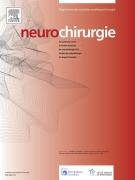Evaluation of parenchymal collaterals in patients with meningioma using contrast-enhanced T1 MPRAGE sequence - 29/03/25
 , Ibrahim Feyyaz Naldemir c, Zakir Sakci d, Mecit Kantarci a
, Ibrahim Feyyaz Naldemir c, Zakir Sakci d, Mecit Kantarci aHighlights |
• | Meningiomas may be accompanied by parenchymal collaterals. |
• | Malignant histologic type, sinus invasion, bone destruction and size increase of meningiomas are predictors of collateral development. |
• | Contrast-enhanced 3D T1-weighted MPRAGE sequence may play an important role in noninvasive assessment of collaterals. |
Abstract |
Background |
Post-contrast T1-MPRAGE sequence has been used in routine tumor imaging at many centers for decades. Meningiomas may be accompanied by leptomeningeal as well as parenchymal collaterals. In this study, we aimed to demonstrate the collaterals that may accompany meningiomas on postcontrast T1-MPRAGE imaging and to investigate their relationship with location, size, histologic features, adjacent bone, and parenchymal changes.
Methods |
In this study, postcontrast T1-MPRAGE images of 326 meningiomas from 259 patients were independently analyzed by two observers. The presence of parenchymal collaterals and unilateral, contralateral or bilateral localization were determined. Meningiomas' diameters, locations, presence of dural sinus invasion, associated parenchymal changes and bony changes were determined. Histologic grades were determined if applicable. The data obtained were analyzed statistically.
Results |
Parenchymal collaterals were demonstrated in 25% of meningiomas (66/259). Of these, 65% were unilateral, 12% contralateral and 23% bilateral. There was a significant correlation between malignancy and the presence of collaterals in histologically diagnosed meningiomas (77%, p = 0.01). The presence of collaterals was also significantly higher in meningiomas with sinus invasion and bone destruction (p < 0.001). As tumor size increased, unilateral and bilateral collateral development increased (p < 0.001, p = 0.008, respectively), but it was not significant in contralateral cases. There was significant concordance between the observers in terms of the presence of collaterals (kappa: 0.773).
Conclusions |
Meningiomas may be accompanied by parenchymal collaterals. WHO grade 3 histologic type, sinus invasion, bone destruction and size increase are predictors of collateral development.
Le texte complet de cet article est disponible en PDF.Keywords : Meningioma, Parenchymal collateral, T1 MPRAGE
Plan
Vol 71 - N° 3
Article 101664- mai 2025 Retour au numéroBienvenue sur EM-consulte, la référence des professionnels de santé.
L’accès au texte intégral de cet article nécessite un abonnement.
Déjà abonné à cette revue ?

